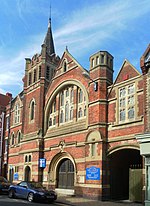Eastbourne rail crash
The Eastbourne rail crash was an accident on the British railway system which occurred on 25 August 1958 at Eastbourne railway station in East Sussex. The accident killed five people and injured 41 others. Eastbourne station is a terminus station with services to Hastings, Brighton, London Victoria. At the time of the accident, there was a further service to Tonbridge via the Cuckoo Line. It was then common for services from Hastings to Brighton to enter Eastbourne and reverse to carry on its journey. Trains between Hastings and Brighton have resumed to do this, while services between London Victoria and Ore still do this today, with some calling at Hampden Park twice and an hourly service to Ashford International starting from Eastbourne.
Excerpt from the Wikipedia article Eastbourne rail crash (License: CC BY-SA 3.0, Authors).Eastbourne rail crash
St. Leonard's Road,
Geographical coordinates (GPS) Address Nearby Places Show on map
Geographical coordinates (GPS)
| Latitude | Longitude |
|---|---|
| N 50.7703 ° | E 0.2831 ° |
Address
Eastbourne Railway Station
St. Leonard's Road
BN21 3UH , Upperton
England, United Kingdom
Open on Google Maps







